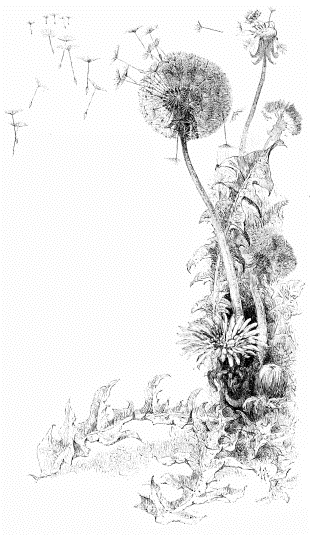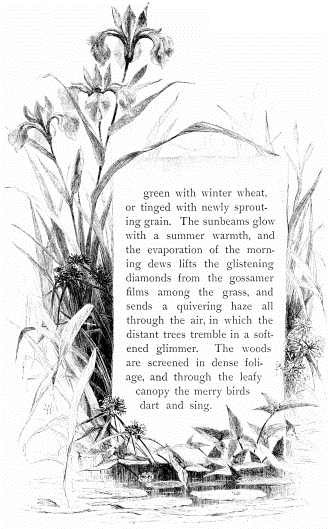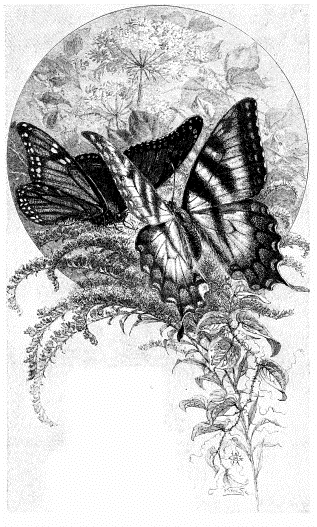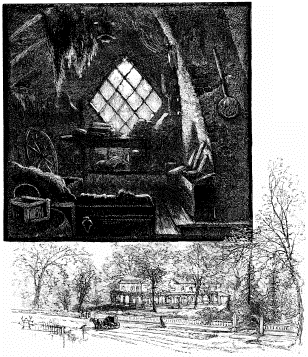
Gibson William Hamilton
Pastoral Days; or, Memories of a New England Year
On the green slope beneath, the scattered dandelions gleam like drops of molten gold upon the velvety sward, and a lounging family group, intent upon that savory noonday relish, gather the basketfuls of the dainty plants for that appetizing “mess of greens.” Often, while thus engaged, have I stopped to watch the antics of the festive bumblebee, tumbling around in the tufted blossom – always an amusing sight. See how he rolls and wallows in the golden fringe, even standing on his head and kicking in his glee! Presently, with his long black nose thrust deep into the yellow puff, he stops to enjoy a quiet snooze in the luxurious bed – an endless sleep, for I generally took this chance to put him out of his misery, preferring, perhaps, to watch the robin hopping across the lawn. Now he stops, and seems to listen; runs a yard or so, and listens again, and without a sign of warning dips his head, and pulls upon an unlucky angle-worm that much prefers to go the other way. It is a well-known fact that angle-worms approach the surface of their burrows at the sound of rain-drops on the earth above. I sometimes wonder if the robin in its quick running stroke of foot intends to simulate that sound, and thus decoy its prey.
I remember the wild tumult of a troop of boys upon the hill-side, tracking the swarming bees as they whirled along in a living tangle against the sky, now loosening in their dizzy meshes, now contracting in a murmuring hum around their queen, and finally settling on a branch in a pendent bunch about her. So tame and docile, too! seeming utterly to forget their fiery javelins as they hung in that brown filmy mass upon the bending bough! “A swarm of bees in May iz wuth a load o’ hay.” So said our neighbor, as with fresh clean hive he secured that prized equivalent. Here they are soon at home again, and we see their steady winged stream pouring out through the little door of their treasure-house, and the continual arrival of the little dusty plunderers, laden with their smuggled store of honey, and their saddle-bags replete with stolen gold. Down near the brook they find a land of plenty, literally flowing with honey, as the luxuriant drooping clusters of the locust-trees yield their brimful nectaries to the impetuous, murmuring swarm. But there is no lack now of flowery sweets for this buzzing colony. On every hand the meadow-sweets and milkweeds, the brambles, and the fragrant creeping-clover show their alluring colors in the universal burst of bloom, and not one escapes its tender pillaging.

Up in the woods the gray has turned to tender green. The flowering dog-wood has spread its layers of creamy blossoms, giving the signal for the planting of the corn, and in the furrowed field we see that dislocated “man of straw,” with old plug hat jammed down upon his face, with wooden backbone sticking through his neck-band, and dirty thatch for a shirt bosom – a mocking outrage on any crow’s sagacity. Those glittering strips of tin, too! Could you but interpret the low croaking of the leader of that sable gang in yonder tree, you might hear of the appalling effect of these precautions. I heard him once as I sat quietly beneath a forest tree, and in the light of later events I readily recalled his remarks upon the occasion: “Say, fellers! look at that old fool down there hanging out those tins to show us where his corn is planted. Haw! haw! I swaw! cawn! cawn! we’ll go down thaw and take a chaw!” And they did; and they perched upon that old plug hat, and looked around for something to get scared about. A single look at a crow shows that he has a long head, and it is not all mouth either.

Every day now makes a transformation in the landscape. The golden stars upon the lawn are nearly all burnt out: we see their downy ashes in the grass. Their virgin flame is quenched, and naught remains but those ethereal globes of smoke that rise up and float away with every breeze. Where is there in all nature’s marvels a more exquisite creation than this evanescent phœnix of the dandelion? Beautiful in life, it is even more beautiful in death. And now the high-grown grass is cloudy with its puffs, whose little fairy parachutes are sailing everywhere, over mountain-top and field. Here the corn has appeared in little waving plumes, and the horse and cultivator are seen breaking up the soil between the rows. Great snowy piles of cloud throw their gliding shadows across the patchwork of ploughed fields and meadows, fresh and

BLUE-FLAGS.
The chickadees are here, and scarlet tanagers gleam like living bits of fire among the tantalizing leaves. Pert little vireos hop inquisitively about you, and the bell note of the wood-thrush echoes from the hidden tree-top overhead. Perhaps, too, you may chance upon a downy brood of quail cuddling among the dry leaves; but, even though you should, you might pass them by unnoticed, except as a mildewed spot of fungus at the edge of a fallen log or tree-stump, perhaps. The loamy ground is shaded knee-deep with rank growth of wood plants. The mossy, speckled rock is set in a fringe of ferns. Palmate sprays of ginseng spread in mid-air a luxurious carpet of intermingled leaves, interspersed with yellow spikes of loosestrife and pale lilac blooms of crane’s-bill; and the poison-ivy, creeping like a snake around that marbled beech, has screened its hairy trunk beneath its three-cleft shiny leaves. The mountain-laurel, with its deep green foliage and showy clusters, peers above that rocky crag; and in the bog near by a thicket of wild azalea is crowned with a profusion of pink blossoms.
Out in the swamp meadow the tall clumps of boneset show their dull white crests, and the blue flowers of the flag, the mint, and pickerel weed deck the borders of the lily pond. The waddling geese let off their shrieking calliopes as they sail out into the stream, or browse with nodding twitch along the grassy bank. Swarms of yellow butterflies disgrace their kind as they huddle around the greenish mud-holes, and we hear on every side the “z-zip, z-zip,” amidst the din of a thousand crickets and singing locusts among the reeds and rushes. The meadows roll and swell in billowy waves, bearing like a white-speckled foam upon their crests a sea of daisies, with here and there a floating patch of crimson clover, or a golden haze of butter-cups. Rising suddenly from the tall grass near by, the gushing brimful bobolink crowds a half-hour’s song into a brief pell-mell rapture, beating time in mid-air with his trembling wings, and alighting on the tall fence-rail to regain his breath. A coy meadow-lark shows his yellow-breast and crescent above the windrow yonder, and we hear the ringing beats of whetted scythes, and see the mowers cut their circling swath.
Mowing! Why, how is this? This surely is not Spring. But even thus the Springtime leads us into Summer. No eye can mark the soft transition, and ere we are aware the sweet fragrance of the new-mown hay breathes its perfumed whisper, “Behold, the Spring has fled!”
SUMMER



“ALL out for Hometown.” There is an epidemic of eagerness, a general bustle for satchels and bundles, and the car is soon almost without a passenger; and, indeed, it would really seem as though the whole train had landed its entire human burden upon this platform; for Hometown is a popular place, and every Saturday evening brings just such an exodus as this: Husbands and fathers who fly from the hot and crowded city for a Sunday of quiet and content with their families, who year after year have found a refuge of peace and comfort in this charming New England town. Where is it? Talk with almost any one familiar with the picturesque boroughs of the Housatonic, and your curiosity will be gratified, for this village will be among the first to be described.
From the platform of the car we step into the midst of a motley assemblage, rustic peasantry and fashionable aristocracy intermingled. Anxious and eager faces meet you at every turn. For a few minutes the air fairly rings with kisses, as children welcome fathers, and fathers children. Strange vehicles crowd the depot – vehicles of all sizes and descriptions, from the veritable “one-hoss shay” to the dainty basket-phaeton of fashion. One by one the merry loads depart, while I, a pilgrim to my old home, stand almost unrecognized by the familiar faces around me. Leaning up against the porch near by, stands a character which, once seen, could never be forgotten. His face is turned from me, but the old straw hat I recognize as the hat of ten years ago, with brim pulled down to a slope in front, and pushed up vertically behind, and the identical hole in the side with the long hair sticking through. Yes, there he stands – Amos Shoopegg. I step up to him and lay my hand upon his shoulder. With creditable skill he unwinds the twist of his intricate legs, and with an inquiring gaze turns his good-natured face toward me.
“Is it possible that you don’t remember me, Shoop?”
With an expression of surprise he raises both his arms. “Wa’al, thar! I swaiou! I didn’t cal’late on runnin’ agin yeu. I was jes drivin’ hum from taown-meetin’, an’ thought as haow I’d take a turn in, jest out o’ cur’osity. Wa’al, naow, it’s pesky good to see yeu agin arter sech a long spell. I didn’t recognize ye at fust, but I swan when ye began a-talkin’, that was enuf fer me. Hello! fetched yer woman ’long tew, hey? Haow air yeu, ma’am? hope ye’er perty tol’ble. Don’t see but what yeu look’s nateral’s ever; but yer man here, I declar for’t, he got the best on me at fust;” and after having thus delivered himself, he swallowed up our hands in his ample fists.
“Yes, Shoop, I thought I’d just run up to the old home for a few days.”
“Wa’al, I swar! I’m tarnal glad to see ye, and that’s a fact. Anybody cum up arter ye? No? Well, then, s’posin’ ye jest highst into my team.” So saying, he unhitched a corrugated shackle-jointed steed, and backed around his indescribable impromptu covered wagon – a sort of a hybrid between a “one-hoss shay” and a truck.
“’Tain’t much of a kerridge fer city folks to ride in, that’s a fact,” he continued, “but I cal’late it’s a little better’n shinnin’ it.” After some little manœuvring in the way of climbing over the front seat, we were soon wedged in the narrow compass, and, with an old horse-blanket over our knees, we went rattling down the hill toward the village and home of my boyhood.
Years have passed since those days when, as a united family, we dwelt under that old roof; but those who once were children are now men and women, with divided interests and individual homes. The old New England mansion is now a homestead only in name, known so only in recollections of the past and the possibilities of the future.
“Wa’al, thar’s the old house,” presently exclaimed Amos, as we neared the brow of a declivity looking down into the valley below. “Don’t look quite so spruce as’t did in the old times, but Warner’s a good keerful tenant, ’tain’t no use talkin’. I cal’late yeu might dig a pleggy long spell afore yeu could git another feller like him in this ’ere patch.”
In the vale below, in its nest of old maples and elms, almost screened from view by the foliage, we look upon the familiar outlines of the old mansion, its diamond window in the gable peering through the branches at us. “Skedup!” cried Amos, as he urged his pet nag into a jog-trot down the hill, through the main street of the town. The long fence in front of the homestead is soon reached, a sharp turn into the drive, a “Whoa, January!” and we are extricated from the wagon.
“Wa’al, I’ll leave ye naow. I guess ye kin find yer way around,” said Shoop, as with one outlandish geometrical stride he lifted himself into the wagon. Cordially greeted by our hostess, with repeated urgings to “make ourselves at home,” we were shown to our room. The house, though clad in a new dress, still retained the same hospitable and cosy look as of old.

OLD HOMESTEAD AND GARRET.
Hometown, owing to some early local faction, is divided into two sections, forming two distinct towns. One, Newborough, a hill-top hamlet, with its picturesque long street, a hundred feet in width, and shaded with great weeping elms that almost meet overhead; and the other, Hometown proper, a picturesque little village in the valley, cuddling close around the foot of a precipitous bluff, known as Mount Pisgah. A mile’s distance separates the two centres. The old homestead is situated in the heart of Hometown, fronting on the main street. The house itself is a series of after-thoughts, wing after wing and gable after gable having clustered around the old nucleus, as the growth of new generations necessitated increased accommodation. Its outward aspect is rather modern, but the interior, with its broad open fireplaces, and accessaries in the shape of cranes and fire-dogs, is rich with all the features of typical New England; and the two gables of the main roof enclose the dearest old garret imaginable – at present an asylum for the quaint possessions of antique furniture and bric-à-brac, removed from their accustomed quarters on the advent of the new host. It is to this sanctuary that my footsteps first lead me, and, with a longing that will not be withstood, I find myself in front of the great white door. I lift the latch; a cool pungent odor of oak wood greets me as I ascend the steep stairs – an odor that awakens, like magic, a hundred fancies, and recalls a host of memories long forgotten. Every stair seems to creak a welcome, as when, on the rainy days of long ago, we sought the cosy refuge to hear the patter on the roof, or to nestle in the dark, obscure corners in our childish games. At the head of the stairs rises the ancient chimney, cleft in twain at the foot, with the quaint little cuddy between. Above me stretch the great beams of oak, like iron in their hardness. Yonder is the queer old diamond window looking out upon the village church, its panes half obscured by the dusty maze of webs. To the left, in a shadowy corner, stands the antiquated wheel – a relic of past generations. Long gray cobwebs festoon the rafters overhead, and the low buzzing of a wasp betrays its mud nest in the gable above. A sense of sadness steals over me as I sit gazing into this still chamber. On every side are mementos of a happy past, and all, though mute, speaking to me in a language whose power stirs the depths of my soul. Wherever the eye may turn, it meets with a silent greeting from an old friend, and the whole shrouded in a weird gloom that lends to the most common object an air of melancholy mystery. And yet it is only a garret. There are some, no doubt, for whom this word finds its fitting synonyme in the dictionary, but there are others to whom it sings a poem of infinite sweetness.
Looking through the dingy window between the maple boughs, my eye extends over lawn and shrubberies, three acres in extent – a little park, overrun with paths in every direction, through ancient orchard and embowered dells, while far beyond are glimpses of the wooded knolls, the winding brook, and meadows dotted with waving willows, and farther still the ample undulating farm.
It is in such a place as this that I have sought recreation and change of scene. My wife and I have run away from the city for a month or so. A vacation we call it; but to an artist such a thing is rarely known in its ordinary sense, and often, indeed, it means an increase of labor rather than a respite. My first week, however, I had consecrated to luxurious idleness. Together we wandered through the old familiar rambles where as boy and girl in earlier days we had been so oft together. Day after day found us in some new retreat. There were dark cool nooks by sheltered

AMONG THE GRASSES.
mist all through the blossoming maze. We heard the music of the scythe, and, sitting in the deep cool grass beneath the maple shade, we watched the circling motion of the mowers in the field – saw the forkfuls of the hay tossed in the drying sun, and breathed the perfumed air that floated from the windrows. We sauntered by the meadow brook where willows gleamed along the bank, and overhanging alders threw their sombre shadows in the quiet pools: where the ground-nut, and the meadow-rue, and the creeping madder fringed the tangled brink, and every footstep started up some agile frog that plunged into the unseen water. We stood where rippling shallows gurgled under festooned canopies of fox-grape, and the leaning linden-trees shut out the sky o’erhead and intertwined their drooping branches above the gliding current. Here, too, the weather-beaten crossing-pole makes its tottering span across the stream, and deep down beneath the bank the rainbow-tinted sunfish floats on filmy fins above his yellow bed of gravel, and we catch a flashing gleam of a silvery dace or shiner turning in the water.
Now we confront a rude slab fence, an ancient landmark, that terminates its length at the edge of the stream, where its gray and crumbling boards are secured with rusty nails against the trunk of a tall buttonwood-tree. A loosened slab is easily found, and we are soon upon the other side; and after picking our way through a forest of bush-elders, we emerge upon an open lot of low flat pasture-land, known always as the “old swamp meadow.” No other five acres on the face of the earth are so dear to me as this neglected field. I know its every rise and fall of ground, its every bog, and its lush greenness is refreshing even to the thought.
It is a luxuriant garden of all manner of succulent and juicy vegetation; an outbursting extravagance of plant life of almost tropical exuberance. All New England’s most majestic and ornamental flora seem congregated in its congenial soil; and even when a boy I learned to know and love them all, and even call them by their names.
Here are towering stems of iron-weed lifting high their scattered purple crowns, and in their midst the woolly clumps of boneset, its white flowered cushions intermingling with the dense pink tufts of thorough-wort.
On every side we overlook whole patches of these splendid blossoms, with their crests closely crowded in a mosaic of pink and white. And here’s a bed of peppermint and spearmint, interspersed with flaming spikes of cardinal lobelia; and here a lusty plant of Indian mallow, entangled in a maze of gold-thread and smart-weed. Here are massive burdocks six feet high, and great trees of jimson-weed, with their large spiral flowers and thorny pods.
High fronds of chain-fern rise up on every side from a jungle of bur-marigolds and clotburs, and tear-thumbs, with their saw-toothed stems and tiny bunches of pink blossoms.
No inch of ground in the old swamp lot but which does its tenfold duty; and what it lacks in quality of produce it amply makes up in quantity. Even a neighboring bed of clean-washed gravel is overrun with creeping mallow, with its rounded leaves and little “cheeses” down among their shadows.

EVEN-TIDE.
Farther on we see the lily-pond, with its surrounding swamp and its legion of crowded water-plants. Here are rank, massive beds of swamp-cabbage, and lofty cat-tails by the thousand among the bristling bogs of tussock-sedge and bulrush. Here are calamus patches, and alder thickets, and sedges without number; and the prickly carex and blue-flag abound on every side. There are galingales and reeds, and tall and graceful rushes, turtle-head and jointed scouring grass, and horse-tail, besides a host of other old acquaintances, whose faces are familiar, but whose names I never knew. But they were all my friends in boyhood. I knew them in the bud and in the blossom, and even in their winter skeletons, brown and broken in the snow. Near by there is a ditch: you never would know it, for it is completely hidden from view beneath an interlacing growth of jewel-weed. But see that gorgeous mass of deep scarlet that floods the farther bank! Nowhere within a circuit of miles around is there such a regal display of cardinal flowers as this: skirting the borders of the ditch for rods and rods, clustering about a ruined, tumbling fence, whose moss-grown pickets are almost hidden in the dense profusion of bloom.
Then there is its airy companion, the “touch-me-not,” with its translucent, juicy stem, and its queer little golden flowers with spotted throats – the “jewel-weed” we used to call it. I know not why, unless from the magic of its leaf, which, when held beneath the water, was transformed to iridescent frosted silver. We all remember its sensitive, jumping seed-pods, that burst even at our approach for fear that we should touch them; but no one can fully appreciate the beauty of the plant who has not seen its silvery leaf beneath the water. Here it justifies its name, for it is indeed a jewel.
How often in those olden times have I lain down among these bulrushes and sedges near the lily pond, and listened to the buzzing songs of the crickets and the tiny katydids that swarmed the growth about me, and filled the air with their incessant din. I remember the little colony of ants that picked their way among the rushes; that gauzy dragon-fly too, that circled and dodged about the water’s edge, now skimming close upon the surface, now darting out of sight, or perhaps alighting on an overhanging sedge, as motionless as a mounted specimen, with wings aslant and fully spread. “Devil’s darning-needles” they were called. The devil may well be proud of them; for darning-needles of such precious metals and such exquisite design are rare indeed. They were of several sizes too. Some were large, and flashed the azure of the sapphire; others fluttered by with smoky, pearly wings, and slender bodies glittering in the light like animated emeralds: and another I well remember, a little airy thing, with a glistening sunbeam for a body, and wings of tiny rainbows.

I remember how I watched the disturbed motion of the arrow-heads out in the water, as the cautious turtles worked their way among them, and crawled out upon the stump close by.
Here they huddled together, a dozen or more, with heads erect, and turning from side to side as they surveyed the surrounding carpet of lily-pads, or listened to the bass-drum chorus of the great green bull-frogs among the pickerel-weed; and when I jumped and yelled at them, what a rolling, sprawling, splashing in the mud! It fairly makes me laugh to think of it. But there is hardly a leaf or wisp of grass in this old swamp lot but what brings back some old association or pleasant reminiscence.

For a week thus we idled, now on the mountain, now in the meadow, while I, with my sketch-book and collecting-box, either whiled away the hours with my pencil, or left the unfinished work to pursue the tantalizing butterfly, or search for unsuspecting caterpillars among the weeds and bushes.

SOME ART CONNOISSEURS.

PROFESSOR WIGGLER.
On a sprig of black alder I found one – the same little fellow as of old, afflicted with the peculiarities of all his progenitors. We used to call him “Professor Wiggler,” owing to an hereditary nervous habit of wiggling his head from side to side when not otherwise employed. To this little humpbacked creature I am indebted for a great deal of past amusement. Distinctly I remember the whack-whack-whack on the inside of the old pasteboard box as the captive pets threatened to dash out their brains in their demonstrations at my approach. Professor Wiggler is really a most remarkable insect, as one might readily imagine from his scientific name, for in learned circles this individual is known as Mr. Gramatophora Trisignata. He has many strange eccentricities. At each moult of the skin he retains the shell of his former head on a long vertical filament. Two or three thus accumulate, and, as a consequence, in his maturer years he looks up to the head he wore when he was a youngster, and ponders on the flight of time and the hollowness of earthly things, or perhaps congratulates himself on the increased contents of his present shell. When fully grown, he stops eating, and goes into a new business. Selecting a suitable twig, he gnaws a cylindrical hole to its centre and follows the pith, now and then backing out of the tunnel, and dropping the excavated material in the form of little balls of sawdust. At length he emerges from the hollow, and again drawing himself in backward, spins a silken disk across the opening, and tints it with the color of the surrounding bark. Here he spends the winter, and comes out in a new spring suit in the following May. Only recently I had in my possession several of these twigs with their enclosed caterpillars, and in every one the color of the silken lid so closely matched the tint of the adjacent bark, although different in each, that several of my friends, even with the most careful scrutiny, failed to detect the deceptive spot. Whether the result of chance or of the instincts of the insect, I do not know; but certain it is that he paints with different colors under varying circumstances.
Insect-hunting had always been a passion with me. Large collections of moths and butterflies had many times accumulated under my hands, only to meet destruction through boyish inexperience; and even in childhood the love for the insect and the passion for the pencil strove hard for the ascendency, and were only reconciled by a combination which filled my sketch-book with studies of insect life.
There was one inhabitant of our fields which had always been to me a never-failing source of entertainment. There he is, the gilded tyrant. I see him now swinging to and fro on his glistening nest of silken threads, his golden yellow form glowing in bold relief against the dark recess in the brambles. My sketch is left in the grass, and I am soon seated in front of the gossamer maze. A festive grasshopper jumps up into my face, and makes a carom on the web. With a spasmodic snap of one hind leg he extricates it from its entanglement, and in another instant would fall from the meshes; but the agile spider is too quick for him. With a movement so swift as almost to elude the eye, he draws from his body a silver cloud of floss, and with his long hind legs throws it over his captive. The head and tail of the grasshopper are now further secured, after which the spider carefully straddles around the struggling insect, and bites off the other radiating webs in close proximity. The unlucky prey now hangs suspended across the opening. With business-like coolness his tormentor dangles himself from the edge of the torn web, and another cataract of glistening floss is thrown up and attached to the under side of the prisoner, after which he is turned round and round, as if on a spit. The stream of floss is carried from head to foot, and in less time than it takes to describe it the victim is wrapped in a silken winding-sheet, and soon meets his death from the poisoned fangs of his captor. Here is but one of the thousands of tragedies that are taking place every hour of the day in our fields. While deeply interested in the closing scenes of this one, I suddenly become aware of a shadow passing over the bushes. I turn my head, and meet the puzzled and pleasant gaze of Amos Shoopegg, as he stands there, hands in pockets, and milk-pail swinging from his wrist.

THE TYRANT OF THE FIELDS.
ward his fringed and weather-beaten neck, and peered over the brambles. “What is’t ye got thar – straddle-bug?” He came still nearer, and looked at the spider. “Wa’al, darn my pictur ef ’tain’t an old yeller-belly! P’r’aps you don’t know that them critters is pizen. Why, Eben Sanford’s gal got all chawed up by one on ’em. Great Sneezer!” he exclaimed, taking three or four strides backward, with both hands uplifted. I had merely raised my hand and gently smoothed the spider.
“Wa’al,” he continued, “yen kin rub ’em daown ef yeu pleze; but fer my part, I’d ruther keep off abaout a good spittin’ distance” – which was the Shoopegg way of expressing a length of about fifteen feet. Amos was crossing lots for his “caow,” he said; but in spite of his plea that the “old heiffer” was “bellerin’” like “Sam Hill,” and was “gittin’ ’tarnal on-easy,” I made him tarry sufficiently long to enable me to send him off a wiser man.
Amos Shoopegg is a type of a large class of the native element of Hometown. Of course, “Shoopegg” is not his actual name. In the long line of his prided Puritan ancestry no one ever bore it before him. This is only an affectionate epithet given him by the village boys full twenty years ago, and it has stuck to him closer than a brother ever since, as those festive surnames always do. Nominally, Amos was a farmer. In summer he was one in fact, and could swing off as pretty a swath in haying as any man in town. But in the winter he changed his vocation, and became a disciple of the “waxed-end.” All day long he could be seen, closeted with a little red-hot stove, plying his trade in his small, square shop, up near the old red school-house. Here he pounded on the big lapstone on his knees, or, with strap and foot-stick in position, punched and tugged around the edge of those marvellous brogans. He made slings and leather “suckers” for the boys, and furnished them with all the black-wax they could chew – or stow-away, to stick between the lining of their pockets. And the huge wooden shoe-pegs that he drove beneath his hammer were a sight to behold. The man who used his “cheap line of goods” might verily say he walked upon a wood-pile.
So they dubbed him “Shoe-peg,” or “Shoop” for brevity. There are others among his neighbors who would furnish an inexhaustible source of study to the student of character. There’s old Rufus Fairchild, known as “Roof,” a rotund specimen of rural jollity, his round face set in dishevelled locks of gray, with a twinkle in his eye and a good word for everybody. And there’s Father Tomlinson, who keeps the post-office down by the dam, as genial an old fellow as ever wrapped up his throat in a white stock. And I might almost continue the list indefinitely. But there is one I must especially mention; and, now that I think of it, he really should have headed the list, for he stands alone – or at least he does sometimes. If you are in search of the embodiment of typical Erin, you need go no farther; here he is. This individual represents another nationality which swells the population of Hometown – the hard-working laborers who toil in the great factory down in the glen, called “Satan’s Misery.” The above personage is one of the best-hearted creatures in the town; but it is the old story, and the world to him is enclosed in the compass of a barrel-hoop. When last I saw him he was in an evident decline, but as I put my finger on his wrist I could still feel the pulsations of the whiskey coursing through his veins.



